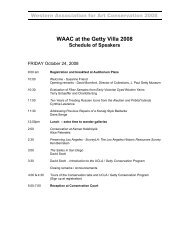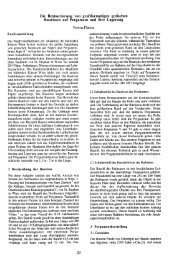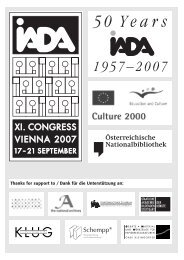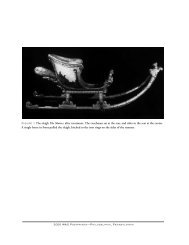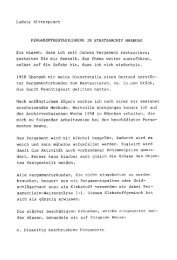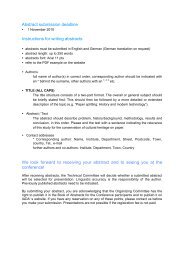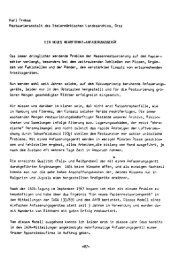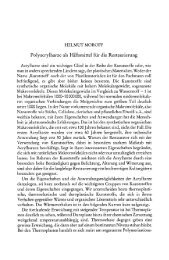Annual Meeting Abstracts, Vol. 31, Num. 1 (2009-01)
Annual Meeting Abstracts, Vol. 31, Num. 1 (2009-01)
Annual Meeting Abstracts, Vol. 31, Num. 1 (2009-01)
Create successful ePaper yourself
Turn your PDF publications into a flip-book with our unique Google optimized e-Paper software.
<strong>Annual</strong> <strong>Meeting</strong> <strong>Abstracts</strong><br />
<strong>Annual</strong> <strong>Meeting</strong> <strong>Abstracts</strong>, continued<br />
The 2008 WAAC <strong>Annual</strong> <strong>Meeting</strong><br />
was held October 24-26<br />
in Los Angeles, California.<br />
The papers from the meeting are<br />
listed below along with summaries<br />
prepared by the speakers.<br />
Evaluation of Fiber Samples<br />
from Early Victorian Dyed<br />
Woolen Yarns<br />
Terry Schaeffer and Charlotte Eng<br />
LACMA recently received a gift of an<br />
early Victorian yarn sample book in<br />
which the majority of the samples are<br />
accompanied by recipes. The dyed<br />
woolen yarns represent a very wide color<br />
palette created completely, according to<br />
the recipes, from colorants and dyeing<br />
assistants that were available before the<br />
advent of coal tar dyes. More than one<br />
person contributed samples and recipes<br />
to the book, which appears to have been<br />
a personal reference work rather than<br />
a sample book for perusal by customers.<br />
The yarns were intended for carpet<br />
manufacture in England.<br />
Many of the large number of color<br />
groups in the book are represented by<br />
several yarns with a range of hues and<br />
depths of shade. The recipes often indicate<br />
that the relative amounts of ingredients<br />
were varied in a systematic<br />
way, suggesting that the makers of the<br />
samples were experimenting to broaden<br />
the range of their color palette. The<br />
majority of the colors do not appear to<br />
be significantly faded.<br />
The availability of this large collection<br />
of samples provides an unusual opportunity<br />
to apply noninvasive and nondestructive<br />
analytical techniques to the<br />
yarns and fiber samples. These results<br />
can then be compared to data obtained<br />
from microchemical analyses performed<br />
on very small fiber samples. Our goals<br />
have been to confirm the presence of ingredients<br />
in the samples with recipes and<br />
to identify ingredients in yarns without<br />
recipes, while consuming as little fiber<br />
as possible.<br />
One method we have used is reflectance<br />
spectroscopy of small clusters of fibers<br />
from the yarns, using a Cary 50 spectrophotometer<br />
with a Barrelino accessory.<br />
Although the reflectance spectra tend to<br />
be relatively featureless and the reflectance<br />
of the fiber samples placed on a<br />
white background is high, we were able<br />
to deduce specific information from the<br />
Kubelka-Munk transforms and derivatives<br />
of the transforms of the spectra.<br />
Interpretation of these results has been<br />
aided by comparison of the data to spectra<br />
of some of Helmut Schweppe’s dyed<br />
woolen yarns in the reference collection<br />
at the Getty Conservation Institute.<br />
Fourier-Transform Infrared, Raman and<br />
x-ray fluorescence spectroscopy, and<br />
x-ray diffractometry, have also been<br />
applied to selected samples from the<br />
Victorian yarn collection. Results have<br />
indicated that a few of the samples were<br />
not dyed according to their accompanying<br />
recipes.<br />
Ten Years of Treating Russian<br />
Icons from the Aleut and Pribolof<br />
Islands<br />
Cynthia Lawrence<br />
This paper discusses an ongoing conservation<br />
project involving icons from<br />
the Aleutian and Pribilof Islands. The<br />
conservation project is coordinated, organized,<br />
and overseen by the Aleutian<br />
Pribilof Heritage Group, a non-profit<br />
entity created by an amendment to the<br />
Aleutian Islands Restitution Act passed<br />
by congress in 1988, to be responsible<br />
for the restoration of six Russian Orthodox<br />
churches, which were pilfered and<br />
damaged during World War II. Once the<br />
church buildings had been restored, the<br />
Heritage Group began the icon conservation<br />
project.<br />
The majority of these icons are of 19thcentury<br />
Russian origin; however, they<br />
range considerably in terms of style,<br />
materials and construction, and condition.<br />
Prior to World War II, the icons<br />
were exposed to relatively extreme environmental<br />
conditions typical of Alaskan<br />
islands, where churches were generally<br />
heated only for services.<br />
During the war, environmental conditions<br />
worsened for paintings left behind<br />
in the churches when residents were<br />
evacuated to internment camps, while<br />
others were buried in barrels or “boxes”<br />
in the ground nearby for three years, and<br />
still others were carried to the internment<br />
camps in the hopes of being placed in<br />
chapels in the camps.<br />
Having been part of the conservation<br />
efforts of a large collection of closely<br />
related objects over a period of time has<br />
allowed for an opportunity to continually<br />
re-evaluate the needs of the objects,<br />
necessary ethical considerations, and<br />
the treatment approaches chosen, and<br />
to gain a better understanding of their<br />
relation to each other and to the needs<br />
of the communities of which they are a<br />
part. How the uniqueness of these works<br />
of art has helped form a general conservation<br />
approach and guided specific<br />
treatment choices is examined in this<br />
presentation.<br />
I have been conserving icons from the<br />
Aleutian and Pribilof Islands for approximately<br />
10 years, after having first been<br />
approached by Vera Espinola, an icon<br />
conservation specialist, in 1997. She had<br />
completed a survey of churches, icons,<br />
and religious objects earlier, as part of a<br />
restoration effort begun by the Aleutian<br />
Pribilof Heritage Group. With monies<br />
paid by the US government as restitution<br />
to the Aleut people, along with<br />
grants from the National Park Service,<br />
and American Express, the Heritage<br />
Group has overseen the restoration of<br />
six churches and rebuilding of one chapel,<br />
and continues to administer to the<br />
conservation of their numerous icons.<br />
This on-going project has been a collaboration<br />
among Vera, members of the<br />
Heritage Group, the Aleut and Pribilof<br />
people - priest and lay - who have devoted<br />
themselves to caring for these icons,<br />
colleagues in both objects and paintings<br />
conservation, and myself. The experience<br />
has caused me to truly appreciate<br />
the uniqueness and integrity of each<br />
artwork I treat; has given me a greater<br />
respect for the significance an artwork<br />
may hold for its owner, steward, or community;<br />
and continues to challenge my<br />
skills, perspectives, and creativity as a<br />
conservator.<br />
x<br />
Addressing Previous Repairs of a<br />
Konaig-Style Baidarka<br />
Dana K. Senge<br />
The Kodiak Island Historical Society<br />
in Kodiak, AK owns and exhibits one<br />
of the five known remaining Koniag-<br />
Style three hole Baidarkas (Kayaks) in<br />
the world. This historical artifact was<br />
extensively examined and treated in<br />
1978 by graduate students of the George<br />
Washington University Conservation<br />
Program. While this was a sound conservation<br />
treatment, the piece is on permanent<br />
exhibit in an historic structure with<br />
little climate control, causing this wood<br />
and skin artifact to continue to change<br />
shape with time. By the early 2000s the<br />
20+ year old repairs had separated from<br />
the skin shell in several locations, and<br />
a new course of treatment was desired<br />
by the museum staff. The treatment of<br />
this piece in the fall of 2007 became a<br />
major project for this small historical<br />
society and museum and included several<br />
educational opportunities for the<br />
conservator, staff, and community in the<br />
structure, history, and preservation of<br />
the watercraft.<br />
The Saites in San Diego<br />
David A. Scott<br />
A coffin from the collections of the San<br />
Diego Museum of Man is described and<br />
examined in this talk. The coffin is one<br />
of a group of six donated to the Museum<br />
of Man in 20<strong>01</strong>. None of the group has<br />
yet been published, and this is the first<br />
account of one of these coffins. Three<br />
of them are suffering from insect infestation<br />
and will later have to be treated<br />
by anoxia fumigation using humidified<br />
nitrogen, but at present the pigments,<br />
grounds, previous restoration, binding<br />
media, wood identification, and aspects<br />
of the hieroglyphic inscriptions on the<br />
coffin will be discussed.<br />
This study forms part of the technical<br />
art historical investigation of ancient<br />
Egyptian pigments, particularly green<br />
pigments, which have often proved to<br />
be difficult to characterize, and which<br />
forms part of an on-going research<br />
project. In the coffin described here,<br />
the pigments and binding media used<br />
are quite conservative, reflecting the<br />
continuation of earlier traditions in the<br />
26-28th Dynasties. The flesh-coloured<br />
face however, contains titanium-based<br />
pigments and is probably a later restoration,<br />
which confounds some art historical<br />
interpretations of the color of the face<br />
of this coffin.<br />
Conservation at Kaman Kalehöyük<br />
Alice Boccia Paterakis<br />
Director of Conservation<br />
Kaman Kalehöyük Excavation<br />
Japanese Institute of Anatolian Archaeology,<br />
Turkey<br />
A summary of several projects that have<br />
been carried out in the Conservation<br />
Laboratory of the Kaman Kalehöyük<br />
excavation in Turkey since 1992 will<br />
be presented including the conservation<br />
treatment and stabilization of archaeological<br />
iron and bronze. The expansion<br />
of the site into an international center<br />
for the study of Anatolian archaeology,<br />
under the auspices of the Japanese Institute<br />
of Anatolian Archaeology, will be<br />
presented with numerous images.<br />
Plans for the future of conservation at<br />
Kaman Kalehöyük consist of moving<br />
into the new conservation laboratory<br />
in <strong>2009</strong>, the renewal of the annual conservation<br />
student internship program,<br />
and holding a workshop in 2<strong>01</strong>0 and a<br />
conference in 2<strong>01</strong>1 for archaeological<br />
conservators.<br />
Preserving Los Angeles -<br />
SurveyLA: the Los Angeles<br />
Historic Resources Survey<br />
Ken Bernstein<br />
Despite its perennial image as a “city of<br />
the future” with little real history, Los<br />
Angeles boasts a diverse and fascinating<br />
architectural heritage. The city of<br />
Los Angeles is now taking a significant<br />
step to identify and protect this rich heritage<br />
by embarking on SurveyLA - its<br />
first-ever citywide historic resources<br />
survey.<br />
SurveyLA will be a comprehensive inventory<br />
of a city that comprises 466 square<br />
miles and 880,000 legal parcels - an area<br />
larger than eight of the nation’s largest cities<br />
combined. The citywide survey is partially<br />
funded by a generous $2.5 million,<br />
five-year grant from the Getty Foundation.<br />
The survey project will make historic resource<br />
information readily accessible on<br />
the city’s website to shape decisions by<br />
policy makers, developers, urban planners,<br />
and property owners.<br />
This presentation will explain how<br />
SurveyLA marks a coming-of-age for<br />
historic preservation in Los Angeles<br />
and can serve as a model for other cities’<br />
efforts to preserve their own fragile<br />
heritage.<br />
Melting Moments: A Technical<br />
Note on the Use of Steam to Remove<br />
Hand Soiling from Stone<br />
Surfaces<br />
J. Claire Dean<br />
Current renovations at the Natural History<br />
Museum of Los Angeles County<br />
have called for the rapid de-installation<br />
and redisplay (in a new location) of<br />
the museum’s Ancient Latin American<br />
Hall, all in the space of three and a half<br />
months. After decades on open exhibit,<br />
many stone items are discoloured and<br />
heavily soiled, the result of thousands of<br />
hands touching exposed surfaces. The<br />
compressed exhibit schedule called for<br />
a fast, effective but safe way to remove<br />
this dirt. The use of a hand held jet<br />
steamer to help break up and remove<br />
the dirt was investigated with pleasantly<br />
surprising results.<br />
Coordinating a Three Year Study<br />
on Federally-Compliant Protective<br />
Clear Coatings for Metals<br />
Tami Lasseter Clare and P. Andrew<br />
Lins<br />
The conservation and preservation professions<br />
in the US and in Europe face the<br />
real prospect that in the near future there<br />
will be no viable clear coating systems to<br />
protect outdoor monuments, sculptures,<br />
18 WAAC Newsletter <strong>Vol</strong>ume <strong>31</strong> <strong>Num</strong>ber 1 January <strong>2009</strong><br />
WAAC Newsletter <strong>Vol</strong>ume <strong>31</strong> <strong>Num</strong>ber 1 January <strong>2009</strong> 19
<strong>Annual</strong> <strong>Meeting</strong> <strong>Abstracts</strong>, continued<br />
<strong>Annual</strong> <strong>Meeting</strong> <strong>Abstracts</strong>, continued<br />
buildings, and other significant artifacts<br />
made of copper or iron alloys against<br />
corrosion and degradation.<br />
If regulations outlawing the use of solvents<br />
common to the formulation and application<br />
of such coatings are expanded<br />
in the next two or three years, the only<br />
options available may be short lived wax<br />
pastes that typically require reapplication<br />
every one to three years and contain<br />
some percentage of solvents that are also<br />
likely to be restricted.<br />
The goal of this project is to develop and<br />
evaluate a new clear coating for metal<br />
that will be environmentally safe and<br />
long lasting, thus saving museums time<br />
and money, as well as reducing hazards<br />
for conservation staff. Over the course<br />
of this three-year project, a double-blind<br />
study of candidate coatings will be undertaken<br />
with participation of volunteer<br />
conservators who will evaluate the coatings<br />
based on qualitative parameters,<br />
such as ease of use, appearance, and<br />
workability.<br />
Concurrently, accelerated and natural<br />
weathering studies of the candidate<br />
coatings on bronze and iron (both<br />
patinated and bare) samples will be<br />
undertaken. The performance of the<br />
coatings during exposure will be analyzed<br />
using electrochemical impedance<br />
spectroscopy and other scientific methods<br />
as required. In this presentation,<br />
the authors wish to share the goals of<br />
the project with the conservation community<br />
and to solicit participants in the<br />
double-blind study.<br />
Car Trouble: The Mass Fumigation<br />
of an Infested Automotive<br />
Collection<br />
Tania Collas<br />
The discovery of a moth infestation<br />
within the Automotive Collection of the<br />
Natural History Museum of Los Angeles<br />
County required a broad-sweeping<br />
response. Webbing clothes moths had<br />
infested the horse-hair upholstery in several<br />
vehicles and appeared to be spreading<br />
among the 45 historic cars housed in<br />
the same storage space. Adding to the<br />
urgency, the Automotive Collection was<br />
scheduled to move into a new storage<br />
facility within the year.<br />
After careful consideration, museum staff<br />
determined that mass fumigation would<br />
be the safest, most effective, and most<br />
practical means of eradicating the moths<br />
before moving the cars into their new pestfree<br />
location. Because of the large number<br />
of infested and potentially infested cars,<br />
fumigation took place in two rounds;<br />
experiences from the first round led to<br />
improvements in the second round.<br />
The fumigation process, while adding a<br />
new level of complication to an already<br />
challenging collection move, proved to<br />
be the best solution to an otherwise overwhelming<br />
problem. The lessons learned<br />
from this mass treatment may help guide<br />
decisions for the treatment of similar<br />
large-scale infestation problems.<br />
Built Heritage Conservation<br />
Education in Southeast Asia<br />
Kecia Fong<br />
Heritage conservation = education + culture<br />
+ relevance. Education = knowledge<br />
+ skills + culture.<br />
The Education department of the Getty<br />
Conservation Institute has recently<br />
launched a regional education and<br />
training initiative for the conservation<br />
of built heritage in Southeast Asia. This<br />
initiative takes into account that heritage<br />
conservation as both concept and act is<br />
multivalent by nature and that education<br />
is informed by culture. Consequently,<br />
the task of improving heritage<br />
conservation demands a multi-faceted<br />
approach.<br />
The Southeast Asia initiative has been<br />
designed in multiple components, each<br />
characterized by a particular activity<br />
and directed towards a specific audience.<br />
These are: field workshops for<br />
conservation professionals; practicing<br />
professionals in the field; didactic materials<br />
for conservation education; educators<br />
and trainers; convening meetings of<br />
topical interest for conservation professionals<br />
who are both directly and indirectly<br />
related to heritage conservation.<br />
Throughout these components the issues<br />
of cultural perspective and values are<br />
considered in the framing of the content<br />
and communication of the information.<br />
Rediscovering a Danish Medieval<br />
Polychrome Altarpiece<br />
Conny Hansen and Marcelle Andreasson<br />
Lunau<br />
National Museum Copenhagen<br />
In 2006–07, a large scale conservation<br />
project took place at the National<br />
Museum in Copenhagen, Denmark. A<br />
polychrome altarpiece originally dated<br />
1470, was brought in for conservation.<br />
The altarpiece consists of 12 apostles, 4<br />
scenes from the life of St. Andrew, and<br />
one large figure of St. Andrew. Furthermore,<br />
the doors of the altar are painted<br />
with eight scenes from the life of Christ.<br />
The quality of the woodwork as well<br />
as the paint layers that emerged is outstanding<br />
considering that the altarpiece<br />
still stands in the small village church<br />
it originally was made for, on the island<br />
of Møn.<br />
This talk is a discussion of the treatment<br />
and the many decisions that were made<br />
throughout the project. Two layers of<br />
over-paint covered the entire altarpiece,<br />
one applied in 1859 and one applied in<br />
1937, and it was clear that the over-paint<br />
caused tension and flaking throughout. It<br />
was of course not easy to define the state<br />
of the original paint layers. One figure<br />
had however been tested and cleaned<br />
a few years earlier and the result was<br />
promising.<br />
A thorough scientific examination of the<br />
colors, paint layers, and original as well<br />
as conservation materials, took place<br />
before the conservation work started.<br />
The treatment consisted mainly of consolidation<br />
and structural stabilization<br />
prior to the removal of the two layers of<br />
over-paint. Some surprising scenes and<br />
facts about the altar were revealed and<br />
the age was redefined by both scientists<br />
and art-historians. The project involved<br />
5 conservators and ended up taking close<br />
to two years.<br />
Still Pictures: Pictures of Stills<br />
and Other Images from the History<br />
of Turpentine<br />
Alan Phenix<br />
In more than one sense, turpentine is<br />
the disappearing artists’ material. Demand<br />
for and use of the material has<br />
declined considerably in recent decades<br />
as a consequence mostly of economic<br />
and environmental pressures.<br />
Despite being a “green” solvent, in the<br />
sense of being carbon-neutral, production<br />
of oil of turpentine has diminished<br />
considerably in the western world. China<br />
is now the world’s leading producer<br />
of this material. Manufacture of oil of<br />
turpentine and rosin (colophony) from<br />
pine resin obtained by scarring of trees<br />
effectively ceased in August 20<strong>01</strong>, so<br />
ending America’s oldest continuous export<br />
industry, older even than tobacco.<br />
Oil of turpentine disappears in other<br />
ways too. It is the traditional thinner or<br />
diluent for artists working with oil-based<br />
paint media and resinous varnishes. But<br />
unlike pigments and binding media, the<br />
use of oil of turpentine (or any other<br />
volatile solvents, such as mineral spirits,<br />
oil of spike lavender, etc.) cannot usually<br />
be detected now in old works of art<br />
by modern techniques of instrumental<br />
analytical chemistry for the simple reason<br />
that all molecular traces have effectively<br />
disappeared from the object by<br />
evaporation.<br />
In the absence of chemical analytical<br />
data which might indicate the history of<br />
use and manufacture of such materials,<br />
we are reliant on historical and documentary<br />
sources for understanding of<br />
this subject.<br />
This talk will present some initial findings<br />
from casual research into the history<br />
of these volatile solvents which started<br />
when the author was a visiting research<br />
scholar at the Getty in 2005-6 and which<br />
he continues on an informal basis. The<br />
focus will be very much on pictorial evidence:<br />
selected images from the history<br />
of the distillation of volatile oils from<br />
its beginnings in classical times through<br />
to the present day. In addition to conventional<br />
sources of technical art history,<br />
the survey takes in material from a wide<br />
range of subject areas including: naval<br />
stores; their commercial and socio-economic<br />
history; marine archaeology; the<br />
history of chemistry and alchemy; the<br />
history of medicine, surgery, and pharmacology;<br />
herbs and ethnobotany; forest<br />
products and forest management; warfare<br />
and incendiary weaponry; history of firefighting;<br />
perfumery, amongst others.<br />
Particularly valuable sources of historical<br />
evidence have been found for the<br />
pine resin (naval stores) industries of the<br />
south-eastern United States and southwestern<br />
France (Les Landes, Gascony),<br />
the latter dating back at least to Romano-<br />
Celtic times.<br />
Important clues to the early development<br />
of essential oil distillation have<br />
also been found in medical and pharmaceutical<br />
treatises of the late Middle<br />
Ages, especially in herbals. Accordingly,<br />
the author believes that it can now be<br />
argued convincingly that knowledge of<br />
distilled volatile oils existed at least as<br />
early as the turn of the fourteenth century<br />
and that distilled oil of turpentine<br />
would have been available to painters<br />
through apothecaries by this date. Even<br />
if it cannot be proved that they actually<br />
used it, oil of turpentine would almost<br />
certainly have been known to the early<br />
painters in oil.<br />
The emergence of distilled volatile oils,<br />
it will be suggested, probably follows<br />
from the discovery of the distillation of<br />
strong alcohol (aqua ardens, aqua vitae)<br />
in which the medical schools of Italy<br />
(Salerno, Bologna) played an important<br />
role.<br />
The Modular Cleaning Program:<br />
Changes and Updates<br />
Chris Stavroudis<br />
In the last year, the MCP has been updated<br />
to a newer version of FileMaker<br />
Pro (a much more arduous task than it<br />
sounds). At the same time, a number of<br />
improvements were made and incorporated<br />
into the database. In addition,<br />
after co-teaching a 4 day workshop in<br />
Montreal with Richard Wolbers, some<br />
of Richard’s more recent thoughts and<br />
concerns have been incorporated into the<br />
database. Richard’s use of micro-conductivity<br />
and pH meters to measure the<br />
ionic environment of a painting surface<br />
will be discussed. How these measurements<br />
can guide a cleaning and how they<br />
have been incorporated into the MCP<br />
methodology will be discussed.<br />
The Conservation of the Born to<br />
the West Movie Banner<br />
Paulette Reading and Camilla Van Vooren<br />
The novel Valley of the Wild Horses<br />
by early 20th-century Western novelist<br />
Zane Grey was adapted to film and<br />
released by Paramount Studios as Born<br />
to the West in 1926. Paulette Reading<br />
of Textile Conservation and Camilla<br />
Van Vooren from the Western Center<br />
for the Conservation of Fine Arts, both<br />
in Denver, Colorado, collaborated on<br />
the treatment of a fabric banner with a<br />
lithographic image advertising the silent<br />
movie, in the collection of the National<br />
Cowboy and Western Heritage Museum<br />
in Oklahoma City.<br />
The paper outlines the testing and lining<br />
of the banner. It includes issues and<br />
choices relating to the adhesive and adhesive<br />
carrier, the choice of lining fabric,<br />
and how the fabric was altered to<br />
better integrate with the object as well<br />
as alignment, registration, handling, and<br />
compensation of the banner.<br />
Into the Wild: WAAC’S Next<br />
<strong>Annual</strong> <strong>Meeting</strong> in Alaska<br />
Scott Carrlee<br />
WAAC’s incoming President, Scott Carrlee,<br />
will present a short DVD highlighting<br />
the venue for next year’s meeting.<br />
If you have ever thought about going<br />
“North to Alaska,” here is your chance.<br />
Glaciers, mountains, eagles, and bears,<br />
there is a good chance you will see all of<br />
these and more at the meeting in Juneau<br />
as well as hear many informative talks.<br />
x<br />
20 WAAC Newsletter <strong>Vol</strong>ume <strong>31</strong> <strong>Num</strong>ber 1 January <strong>2009</strong><br />
WAAC Newsletter <strong>Vol</strong>ume <strong>31</strong> <strong>Num</strong>ber 1 January <strong>2009</strong> 21
<strong>Annual</strong> <strong>Meeting</strong> <strong>Abstracts</strong>, continued<br />
The theme for next year’s meeting is<br />
“Conservation in the Extreme,” and the<br />
extreme landscape of Alaska will serve<br />
as a fitting backdrop. So start your planning<br />
NOW!<br />
Light after Dark: A Second<br />
Homecoming for Louise Nevelson's<br />
Night Presence II<br />
Donna Williams<br />
In 2006 Williams Art Conservation and<br />
the San Diego Museum applied for and<br />
received an Institute for Museum and<br />
Library Services grant to restore Night<br />
Presence II, a sculpture by Louise Nevelson,<br />
which has been in the museum’s<br />
permanent collection for 32 years. Past<br />
treatments as well as years of exposure<br />
in their outdoor sculpture garden had resulted<br />
in serious aesthetic and structural<br />
damage to the piece.<br />
The 3000-pound structure was trucked<br />
to a facility in North Haven, CT.<br />
Working with the sculpture’s original<br />
fabricators Alfred and Donald Lippincott,<br />
the conservator designed specific<br />
treatment methods to remove overpaint<br />
and repair surface pitting as well as<br />
perforations in the steel itself. Following<br />
completion of structural treatment<br />
in June 2008, the artwork was re-located<br />
to Donald Lippincott’s property<br />
for “weathering” to expedite surface<br />
corrosion and color.<br />
In December 2008, the piece is scheduled<br />
for trucking back to the San Diego<br />
Museum of Art, where it will be installed<br />
in a new location for continued public<br />
exhibition in an exterior location.<br />
Working with Large Format<br />
Photographs at the Getty<br />
Sarah Freeman, Marc Harnly, and Lynne<br />
Kaneshiro<br />
With the 2007 exhibition Recent History:<br />
Photographs by Luc Delahaye,<br />
conservators and framers at the J. Paul<br />
Getty Museum were required to prepare<br />
photographs in excess of 4’ x 5’ (48 x<br />
60”) for display in the Center for Photographs.<br />
This project gave Getty staff an<br />
opportunity to challenge the new space<br />
and to learn new strategies for the display<br />
and care of contemporary art, a relatively<br />
new aspect of the museum’s collection.<br />
The experience of mounting, framing,<br />
glazing, and lighting these large photographs<br />
will be described. A review<br />
of materials currently available for use<br />
with photographs of this scale will also<br />
be presented. This will include adhesives<br />
and rigid supports for mounting,<br />
as well as glazing and other materials<br />
for framing.<br />
A Presentation on Cast Bronze<br />
Mounts for Temporary Exhibits<br />
Mark Mitton and Adrienne Pamp<br />
This talk will address the challenge of<br />
making robust mounts for loan objects<br />
while faced with limitations of time<br />
and limited access to objects. Solutions<br />
discussed involve the manufacture of a<br />
large number of mounts that need to be<br />
custom fitted in a short span of time. If<br />
profiles of objects can be obtained in<br />
advance, the mounts can be produced<br />
in large numbers prior to the arrival of<br />
a loan exhibition.<br />
The presentation will chronicle the<br />
steps taken from initial design, stages of<br />
manufacture, and final installation. This<br />
includes the final fitting of the mounts<br />
upon the arrival of objects at the Getty<br />
Museum. We will use examples from the<br />
installation of three temporary exhibitions<br />
at the Getty Center featuring stone,<br />
bronze, and ceramic sculpture.<br />
What is Washi? Looking into<br />
Basics of Materials, Manufacture,<br />
and Terminology of Contemporary<br />
Japanese Paper<br />
Soko Furuhata<br />
Although Japanese paper, known as<br />
Washi, is one of the most common materials<br />
used in the field of paper conservation,<br />
conservators often are not really<br />
aware of all materials and the details of<br />
the methods for making it.<br />
Terminologies commonly used in association<br />
with the word Washi are quite<br />
often misused from the lack of understanding.<br />
In April 2008, a tour to Japan<br />
was organized by Hiromi Katayama<br />
of Hiromi Paper International Inc. and<br />
Betty Fiske, former Winterthur Museum<br />
Adjunct Professor of Winterthur/ University<br />
of Delaware Program in Art Conservation.<br />
Paper conservators on the trip<br />
were given an opportunity to visited several<br />
papermaking sites. Through images<br />
taken during the tour, basics of several<br />
contemporary Japanese papermaking<br />
techniques will be presented.<br />
Searching for an Answer –<br />
Some Possible Alternatives to<br />
PhillySeal R Epoxy Putty<br />
Jeff Maish, BJ Farrar, and Mara Schiro<br />
An epoxy putty produced by Philadelphia<br />
Resins, PhillySeal R (formerly<br />
Pliacre), has been used widely in conservation<br />
and mountmaking for the past<br />
two decades. The epoxy product provided<br />
a useful substrate for fills as well<br />
as a mountmaking interface layer for a<br />
range of object types.<br />
A replacement search was initiated following<br />
the cessation of PhillySeal’s production<br />
in 2007. This search highlighted<br />
the difficulties of replacing proprietary<br />
products but also presented the opportunity<br />
to explore and test a broader range<br />
of epoxy pastes and putties. Preliminary<br />
review of properties and costs coupled<br />
with Oddy testing points to some possible<br />
alternative products.<br />
Ultraviolet-Excited Fluorescense<br />
Photography and Reflectance UV<br />
Photography in Art Conservation<br />
Yosi Pozeilov<br />
This talk reviews traditional methods<br />
for the photography of works of art using<br />
UV radiation as a source and updates<br />
these procedures for use with current<br />
digital imaging equipment. The use of<br />
off-the-shelf cameras, lights, and filters,<br />
will be highlighted and examples<br />
provided.<br />
22 WAAC Newsletter <strong>Vol</strong>ume <strong>31</strong> <strong>Num</strong>ber 1 January <strong>2009</strong>



